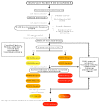Dyslipidemia in Transplant Patients: Which Therapy?
- PMID: 35887846
- PMCID: PMC9318180
- DOI: 10.3390/jcm11144080
Dyslipidemia in Transplant Patients: Which Therapy?
Abstract
Cardiovascular disease is the most important cause of death worldwide in recent years; an increasing trend is also shown in organ transplant patients subjected to immunosuppressive therapies, in which cardiovascular diseases represent one of the most frequent causes of long-term mortality. This is also linked to immunosuppressant-induced dyslipidemia, which occurs in 27 to 71% of organ transplant recipients. The aim of this review is to clarify the pathophysiological mechanisms underlying dyslipidemia in patients treated with immunosuppressants to identify immunosuppressive therapies which do not cause dyslipidemia or therapeutic pathways effective in reducing hypercholesterolemia, hypertriglyceridemia, or both, without further adverse events.
Keywords: cardiovascular disease; dyslipidemia; immunosuppressive therapy; organ transplant.
Conflict of interest statement
The authors declare no conflict of interest.
Figures


References
-
- Roth G.A., Mensah G.A., Johnson C.O., Addolorato G., Ammirati E., Baddour L.M., Barengo N.C., Beaton A.Z., Benjamin E.J., Benziger C.P., et al. Global Burden of Cardiovascular Diseases and Risk Factors, 1990–2019: Update from the GBD 2019 Study. J. Am. Coll. Cardiol. 2020;76:2982–3021. doi: 10.1016/j.jacc.2020.11.010. - DOI - PMC - PubMed
-
- Ference B.A., Ginsberg H.N., Graham I., Ray K.K., Packard C.J., Bruckert E., Hegele R.A., Krauss R.M., Raal F.J., Schunkert H., et al. Low-density lipoproteins cause atherosclerotic cardiovascular disease. 1. Evidence from genetic, epidemiologic, and clinical studies. A consensus statement from the European Atherosclerosis Society Consensus Panel. Eur. Heart J. 2017;38:2459–2472. doi: 10.1093/eurheartj/ehx144. - DOI - PMC - PubMed
-
- Fernández-Friera L., Peñalvo J.L., Fernández-Ortiz A., Ibañez B., López-Melgar B., Laclaustra M., Oliva B., Mocoroa A., Mendiguren J., Martínez de Vega V., et al. Prevalence, Vascular Distribution, and Multiterritorial Extent of Subclinical Atherosclerosis in a Middle-Aged Cohort: The PESA (Progression of Early Subclinical Atherosclerosis) Study. Circulation. 2015;131:2104–2113. doi: 10.1161/CIRCULATIONAHA.114.014310. - DOI - PubMed
Publication types
LinkOut - more resources
Full Text Sources

